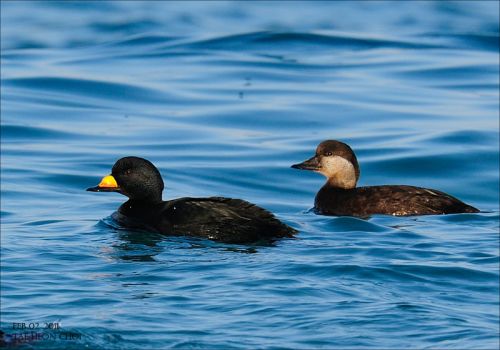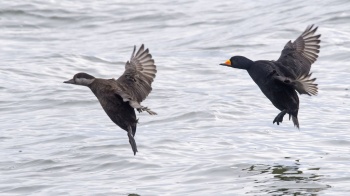Alternative name: American Scoter
- Melanitta americana
Identification
43–54 cm (17-21¼ in)
Adult males are easily identified by the yellow protuberance on the top of the bill at the base and by their entirely black plumage with grayish-white wing linings, sometimes visible in flight. Adult females have a dark bill, overall dark brown body with a contrasting dark cap and light cheeks. In the breeding season, the dark cap may become less conspicuous to camouflage them on the nest. In winter, some females can orange above the nostrils, but never show the bulbous yellow knob of the males.
Similar Species
Male Common Scoter is similar but has a black knob at base of bill with a patch of yellow in front. It also has a thin yellow eyering and thinner neck than male Black Scoter. Females are indistinguishable. Surf Scoter is larger with a more massive yellow, orange, black and white patterned bill. Female Surf Scoter may appear dark-capped but has two pale patches on the side of its face. White-winged Scoter and Velvet Scoter are larger still with white secondaries and white markings around their eyes. Females can be confused with female Red-crested Pochard which has a white wing bar and Long-tailed Duck which has a smaller bill and much whiter underparts.
Distribution
Black Scoter has an extensive North American distribution with widely separated breeding populations in Alaska and Northern Quebec. Also a small population breeds in the Russian Far East. This species winters south on the coasts of the northern USA and Canada, and in Asia as far south as China.
Taxonomy
This is a monotypic species.
It was formerly thought to be conspecific with Common Scoter.
Habitat
Winters on sea-coasts, usually at some distance from the shore.
Breeds on inland lakes or rivers, in woodland or tundra.
Behaviour
Actions
- Gregarious, may form very large flocks, especially with Velvet Scoter or Surf Scoter.
- Pointed tail is often raised.
- Flies low to the water in long lines. Flight is strong and rapid.
- Dives with a small leap.
Diet
The diet includes crustaceans and molluscs, insects and their larvae, fish eggs and vegetation such as duck weed while nesting on freshwater.
Breeding
The nest is built on the ground. The clutch consists of 5-7 eggs and are incubated for 27 to 31 days.
Vocalisations
Highly vocal, groups of can often be located by the constant mellow, plaintive whistling call of the males.
Movements
- Spring migration takes place overland at night.
- Autumn migration is along the coast during the day.
References
- Clements, J. F., T. S. Schulenberg, M. J. Iliff, D. Roberson, T. A. Fredericks, B. L. Sullivan, and C. L. Wood. 2018. The eBird/Clements checklist of birds of the world: v2018. Downloaded from http://www.birds.cornell.edu/clementschecklist/download/
- Avibase
- Hayman, P. (2002) The New Birdwatcher's Pocket Guide to Britain and Europe. Mitchell Beazley. ISBN 1-85732-804-3
- Fitter, R. S. R. (1966). Pocket Guide to British Birds. London: Collins.
- Peterson, RT, G Mountfort and PAD Hollom. 1993. Collins Field Guide – Birds of Britain and Europe, 5th Revised edition. London: HarperCollins Publishers. ISBN 978-0002199001
- Grant, P.J., K. Mullarney, L. Svensson, D. Zetterstrom (1999) Collins Bird Guide: The Most Complete Field Guide to the Birds of Britain and Europe. Harpercollins Pub Ltd ISBN 0 00 219728 6
- 51st supplement to the AOU checklist of North American birds
- Bordage, D. and J. L. Savard (2011). Black Scoter (Melanitta americana), version 2.0. In The Birds of North America (A. F. Poole, Editor). Cornell Lab of Ornithology, Ithaca, NY, USA. https://doi.org/10.2173/bna.177
- del Hoyo, J., Collar, N. & Kirwan, G.M. (2019). Black Scoter (Melanitta americana). In: del Hoyo, J., Elliott, A., Sargatal, J., Christie, D.A. & de Juana, E. (eds.). Handbook of the Birds of the World Alive. Lynx Edicions, Barcelona. (retrieved from https://www.hbw.com/node/467115 on 21 May 2019).
Recommended Citation
- BirdForum Opus contributors. (2024) Black Scoter. In: BirdForum, the forum for wild birds and birding. Retrieved 27 April 2024 from https://www.birdforum.net/opus/Black_Scoter
External Links
Use Melanitta americana to
Use Black Scoter to
GSearch checked for 2020 platform.





